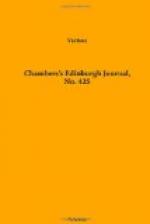The experiments with prussic acid are worthy the attention of entomologists, with whom it is often a matter of importance to kill an insect with the least possible amount of injury. In these instances, the plan pursued was to charge a small tube with the acid, and place it inside that containing the insects. The vapour of 1-16th of a grain was sufficient to destroy bees and flies; and that of seven grains proved fatal to large beetles, and the largest kind of bees. Although as yet the investigation has taken but a limited range, it will be seen that it opens a wide field of research: the next step will be to group or class those agents which appear to have produced similar effects. It is remarkable, as Dr Davy observes, ’that most of the substances which, even in minute portions mixed with common air, prevent the slow combustion of phosphorus, as indicated by its shining in the dark, have the effect, on the insects on which they were tried, of suspending animation.’
He says further: ’Some of the results may not be undeserving notice for practical purposes—as those in the instances of sulphuretted hydrogen, oil of turpentine, and camphor, in relation to the destruction of parasitical insects, whether infesting plants or minerals, or to the preservation of substances from the attacks of insects. To be applicable to the preservation of plants, of course it is necessary that the agents to be used should not exercise on them any materially injurious effects. This must be determined by experiments made expressly for the purpose. The few trials I have yet made on seeds seem to shew, that the steeping them in a solution in water of sulphuretted hydrogen has not prevented their germination. The seeds tried were mignonette, cress-seed, and that of a Nemophila: analogy—namely, that of steeping the seed of the cerealia in a solution of the white oxide of arsenic, is in favour of the same conclusion. Further, for the preservation of articles, whether of clothing or furniture, it is hardly less necessary that the substances to be employed should have no offensive odour. Judging from the effects of attar of roses, and from what we know of scented woods not being liable to be attacked by insects, the probability is, that any volatile oil of agreeable perfume will answer the purpose required, and prove a true instance of the utile et dulce combined.
’As carbonic acid gas, and some of the other agents mentioned, produce merely a temporary torpor, it may be a question whether this gas, or simple immersion in water, may not be advantageously substituted for the fumes of burning sulphur, destructive of life, at the yearly gathering of honey; the former, indeed, may be said to be in use in the Levant, where the smoke of the fire of leaves, in which the carbonic acid generated may be considered as chiefly operative, is employed to stupify the bees preparatory to the spoiling of their hives.’




